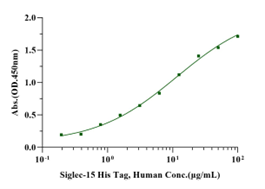Phe20-Thr263, with C-terminal 10*His FVRTKIDTTENLLNTEVHSSPAQRWSMQVPPEVSAEAGDAAVLPCTFTHPHRHYDGPLTAIWRAGEPYAGPQVFRCAAARGSELCQTALSLHGRFRLLGNPRRNDLSLRVERLALADDRRYFCRVEFAGDVHDRYESRHGVRLHVTAAPRIVNISVLPSPAHAFRALCTAEGEPPPALAWSGPALGNSLAAVRSPREGHGHLVTAELPALTHDGRYTCTAANSLGRSEASVYLFRFHGASGASTGGGSGGGSHHHHHHHHHH
We identified Siglec-15 as a critical immune suppressor with broad upregulation on various cancer types and a potential target for cancer immunotherapy. Siglec-15 has unique molecular features compared to many other known checkpoint inhibitory ligands. It shows prominent expression on macrophages and cancer cells and a mutually exclusive expression with PD-L1, suggesting that it may be a critical immune evasion mechanism in PD-L1 negative patients. Interestingly, Siglec-15 has also been identified as a key regulator for osteoclast differentiation and may have potential implications in bone disorders not limited to osteoporosis. As a new player in the cancer immunotherapeutic arena, Siglec-15 may represent a novel class of immune inhibitors with tumor-associated expression and divergent mechanisms of action to PD-L1, with potential implications in anti-PD-1/PD-L1 resistant patients.


Immobilized Siglec-15 His Tag, Human (Cat. No. UA010421)
at 10μg/mL (100μL/well) can bind Neu5Acα2-6GalNAcα-sp3-PAA-biot with EC50 of 8.55-18.10μg/ml.